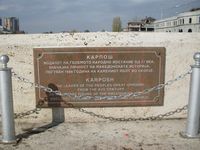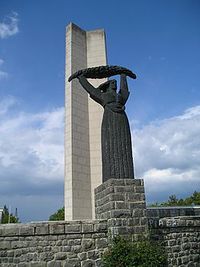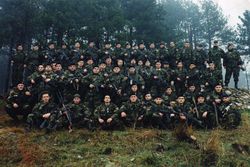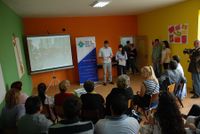كومانوڤو
كومانوڤو
Куманово Kumanovo | |
|---|---|
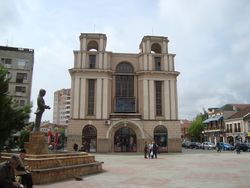 الميدان الرئيسي في كومانوڤو | |
 خريطة كومانوڤو | |
| الإحداثيات: 42°08′09″N 21°43′05″E / 42.13583°N 21.71806°E | |
| البلد | مقدونيا |
| البلدية | بلدية كومانوڤو |
| الحكومة | |
| • العمدة | Zoran Damjanovski (SDSM) |
| المساحة | |
| • المدينة | 509٫48 كم² (196٫71 ميل²) |
| المنسوب | 340 m (1٬120 ft) |
| التعداد (2002) | |
| • المدينة | 70٬842 |
| • الكثافة | 207٫04/km2 (536٫2/sq mi) |
| • العمرانية | 105 484 |
| منطقة التوقيت | UTC+1 (CET) |
| Postal codes | 1300 |
| مفتاح الهاتف | +389 (0)31 |
| Car plates | KU |
| Patron saints | St. George[1] |
| الموقع الإلكتروني | Official Page |
كومانوڤو (مقدونية: Куманово [kuˈmanɔvɔ] (![]() استمع)؛ إنگليزية: Kumanovo) هي مدينة في جمهورية مقدونيا وهي مقر بلدية كومانوڤو التي هي أكبر بلدية في البلد. مؤسسات البلدية تضم مجلس المدينة، العمدة وهيئات ادارية أخرى.
استمع)؛ إنگليزية: Kumanovo) هي مدينة في جمهورية مقدونيا وهي مقر بلدية كومانوڤو التي هي أكبر بلدية في البلد. مؤسسات البلدية تضم مجلس المدينة، العمدة وهيئات ادارية أخرى.
أصل الاسم
اسم المدينة في الألبانية هو Kumanova أو Kumanovë، وفي التركية هو Kumanova، بينما في الصربية والبلغارية هو نفسه كما في المقدونية: Kumanovo (Куманово). الاسم مشتق من القبائل القومان، وهي قبيلة تركية غزت المنطقة في أوائل القرن الثاني عشر.[2]
الجغرافيا
تقع كومانوفو في الجزء الشمالي الشرقي من مقدونيا، بالقرب من العاصمة سكوپيه.
الديمغرافيا
التاريخية
يوضح الجدول التالي زيارات تاريخية لكومانوفو مع عدد المنازل التي سجلها الزائر:
| اسم الرحالة | سنة زيارته كومانوڤو | عدد البيوت/التعداد |
|---|---|---|
| Pukvil | 1800 | 300 منزل |
| Gomera | 1810 | 800 نسمة |
| Dupničanin | 1835 | 5,000 نسمة |
| Bue | 1838 | 3-4,000 نسمة |
| Bue | 1854 | 3,000 نسمة |
| Papadopulos | 1856 | 200 منزل |
| Reports | 1859 | 4,500 نسمة |
| Han | 1862 | 3,200 نسمة |
| Hadzi Vasiljevič | 1865 | 650 منزل |
| Timaev | 1865 | 4,200 نسمة |
| Harački's List | 1868 | 721 منزل |
| Bjankoni | 1885 | 7,000 نسمة |
| Novakovič | 1886 | 8,000 نسمة |
| Petrov | 1886 | 8,000 نسمة |
| Sal-Name | 1887 | 900 منزل |
| Veselinovič | 1887 | 5,000 نسمة |
| Gopčevič | 1889 | 5,700 نسمة |
| Petrov | 1896 | 2,100 منزل |
| Knčev | 1900 | 14,530 نسمة |
| Župančič | 1903 | 14,530 نسمة |
| Hadzi Vasiljevič | 1907 | 15,000 نسمة |
يوضح الجدول أدناه التطور الديموغرافي التاريخي وفقاً لبيانات التعداد السكاني ليوغوسلافيا ومقدونيا:
| المجموعة العرقية |
تعداد 1948 | تعداد 1953 | تعداد 1961 | تعداد 1971 | تعداد 1981 | تعداد 1994 | تعداد 2002 | |||||||
|---|---|---|---|---|---|---|---|---|---|---|---|---|---|---|
| العدد | % | العدد | % | العدد | % | العدد | % | العدد | % | العدد | % | العدد | % | |
| المقدونيون | .. | .. | 14,351 | 61.5 | 20,323 | 66.1 | 28,789 | 62.1 | 36,812 | 60.5 | 40,634 | 62.3 | 42,840 | 60.5 |
| الألبان | .. | .. | 951 | 4.0 | 1,893 | 6.2 | 7,827 | 16.9 | 12,997 | 21.4 | 15,612 | 23.9 | 18,277 | 25.8 |
| أتراك | .. | .. | 3,858 | 16.5 | 2,512 | 8.2 | 1,791 | 3.9 | 936 | 1.5 | 241 | 0.4 | 256 | 0.4 |
| روما | .. | .. | 1,861 | 8.0 | .. | .. | 3,013 | 6.5 | 4,415 | 7.3 | 2,987 | 4.6 | 4,042 | 5.7 |
| ڤلاخ | .. | .. | 12 | 0.1 | .. | .. | .. | .. | 44 | 0.1 | 85 | 0.1 | 108 | 0.2 |
| الصرب | .. | .. | 1,790 | 7.7 | 2,808 | 9.1 | 3,759 | 8.1 | 4,252 | 7.0 | 5,097 | 7.8 | 4,727 | 6.7 |
| البشناق | .. | .. | 0 | 0.0 | 0 | 0.0 | 0 | 0.0 | 0 | 0.0 | 0 | 0.0 | 14 | 0.0 |
| غيرهم | .. | .. | 516 | 2.2 | 3,226 | 10.5 | 1,184 | 2.6 | 1,386 | 2.3 | 577 | 0.9 | 578 | 0.8 |
| الإجمالي | 20,242 | 23,339 | 30,762 | 46,363 | 60,842 | 65,233 | 70,842 | |||||||
الوضع الحالي
بلغ عدد سكان مدينة كومانوفو وفقًا لتعداد عام 2002 حوالي 77,561 نسمة، يشكل المقدونيون العرقيون الأغلبية بنسبة 62.4% (48,416)، مع وجود أقلية كبيرة من الألبان بنسبة 23.7% (18,369) والصرب بنسبة 7.4% (5,746).[4]
كانت اللغات الأم الأكثر شيوعًا في المدينة كالتالي:
- المقدونية: 45,306 (64.0%)
- الألبانية: 18,283 (25.8%)
- الرومانية: 4,007 (5.7%)
- الصربية: 2,399 (3.4%)
- التركية: 215 (0.3%)
- أخرى: 632 (0.9%)
كان التكوين الديني للمدينة على النحو التالي:
- المسيحية الأرثوذكسية الشرقية: 46,766 (66.0%)
- الإسلام: 22,483 (31.7%)
- أخرى: 1,593 (2.3%)
التاريخ
قبل التاريخ
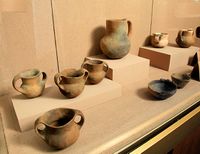
تتميز المنطقة بوجود العديد من المستوطنات ما قبل التاريخ، من بينها كوستوبرسكا كارب، مستوطنة العصر البرونزي "غراديشته" بالقرب من قرية بلينتسه، الموقع النيوليتي "ملادو ناغوريتشاني"، تلة الدفن "غروبلجه" في فوينيك، مقبرة دريزغا الرومانية في لوباته، ومستوطنة "ڤيتسيانوس" الرومانية في قرية كليتشوڤتسي.
الفترة العثمانية
ذُكرت المدينة لأول مرة في القرن السابع عشر.[5] وصفها أوليا چلبي في الفترة 1660–61 قائلاً: "تقع مستعمرة كومانوفو في أراضي سنجق سكوپيه وتُمثل إحدى المقاطعات. المدينة مزدانة بالعديد من الأنهار و600 منزل مغطى بالبلاط. المسجد في وسط المدينة جميل، وهناك تكية، مدرسة دينية، حمام، وعدد من المتاجر والطواحين المائية؛ والمناخ لطيف ومريح. توجد العديد من الكروم والحدائق".[بحاجة لمصدر]
في عام 1689، قاد كارپوش، وهو قائد هايدوك في منطقة دوسپات (حاليًا في بلغاريا)، تمردًا ضد العثمانيين مستغلاً ضعفهم والتذمر من السياسات الضريبية العالية. امتدت ثورة كارپوش بسرعة، مما أدى إلى تحرير كراتوفو، كريڤا بالانكا، كومانوفو، كاتشانك ومدن أخرى. قاتل السكان المسيحيون المحليون بجانب الجيش النمساوي بقيادة الإمبراطور ليوبولد الأول لتحرير سكوپيه وشتيب. ومع ذلك، تغير الوضع العسكري والسياسي في البلقان لصالح العثمانيين، مما أدى إلى سحق الثورة. هاجم العثمانيون كريڤا بالانكا، معقل الثوار، ثم هاجموا كومانوفو وحصنها الجديد، حيث أُسر كارپوش وأُعدم على جسر الحجر فوق نهر فاردار.
حرب البلقان الأولى
في أكتوبر 1912، خلال حرب البلقان الأولى، حققت القوات الصربية بقيادة الجنرال رادومير بوتنيك انتصارًا حاسمًا على العثمانيين شمال المدينة. أنهت معركة كومانوفو التي استمرت يومين السلطة العثمانية في مقدونيا فاردار ومهدت الطريق لدمج المنطقة في يوغوسلافيا. قُسمت مقدونيا إلى ثلاث مناطق بين صربيا واليونان وبلغاريا بعد معاهدة بوخارست عام 1913.
الحرب العالمية الثانية
بدأت الانتفاضة ضد الفاشية من قبل المقدونيين والنضال من أجل التحرير الوطني والاجتماعي في كومانوفو وبريليب في 11 أكتوبر 1941.
التاريخ الحديث
الثورة الألبانية 2001 والعلاقات الطائفية
بدأت الثورة الألبانية في مقدونيا عام 2001 من المناطق الجبلية المحيطة بـتيتوڤو وامتدت في مايو 2001 إلى منطقة كومانوفو، خصوصًا شمالها. أدى الصراع المسلح في كومانوفو بشكل رئيسي إلى انقسام النظام التعليمي على أساس عرقي، حيث غادر جميع الطلاب الناطقين باللغة الألبانية المدارس وطالبوا بفتح مدارس جديدة. أدى هذا الانقسام إلى فصل واضح في المدينة أثر على العلاقات بين المجتمعات المختلفة.
ينص قانون الإدارة المحلية، المادة 44 (Sl.besnik br.5/2002)، على إنشاء لجنة العلاقات بين المجتمعات (CICR). وتعد CICR هيئة استشارية داخل مجلس بلدية كومانوفو، وتتشكل من 12 ممثلاً عن الجماعات العرقية المقدونية، الألبانية، الرومانية، الصربية، التركية، والڤلاخ. تهدف اللجنة إلى تطوير وتحسين العلاقات بين المجتمعات العرقية وضمان مشاركة الأقليات في اتخاذ القرارات المتعلقة بالقضايا العرقية التي تُدرج ضمن جدول أعمال مجلس بلدية كومانوفو.
تشمل المنظمات الأخرى التي تعمل على تقليل الانقسام بين المجتمعات مركز الحوار بين الثقافات (CID)، ومركز مجتمع الروم DROM، والصليب الأحمر المحلي، وغيرها. يُعتبر مركز MultiKulti للشباب الذي يديره CID كومانوفو من أكثر الأنظمة فعالية لدعم الانقسام بين المجتمعات. تقدم هذه المراكز مساحة للشباب للقاء والتعلم عن بعضهم البعض، بالإضافة إلى توفير الدعم للشباب.
الاقتصاد
تعد صناعات معالجة المعادن، التبغ، الزراعة، الأحذية، والمنسوجات في المدينة سببًا في جعلها مركزًا اقتصاديًا وتجاريًا وثقافيًا يضم حوالي 135,529 نسمة. تطورت الزراعة والتجارة بشكل رئيسي في القرن التاسع عشر، ولكن المظهر الحديث للمدينة تم تحقيقه بعد الحرب العالمية الثانية.
معرض صور
البلدات التوأم — المدن الشقيقة
كومانوفو متوأمة مع المدن والبلديات التالية:[6]
انظر أيضاً
غيرهم
| قائمة البلدان التي حكمت كومانوڤو |
|---|
الهامش
- ^ bbcamerica.com Five Facts About Saint George, For Saint George’s Day April 23, 2014
- ^ Macedonia, Bradt Travel Guide, Thammy Evans, Bradt Travel Guides, 2010, ISBN 1-84162-297-4, p. 257.
- ^ Censuses of population 1948 - 2002
- ^ Macedonian census, language and religion
- ^ Istorija, Sojuz na istoriskite društva na SR Makedonija, Sojuz, 1970q p. 146.
- ^ Kumanovo sister cities (Збратимени градови со Општина Куманово)
المصادر
- Srpsko geografsko društvo (1972). Glasnik 52 (in Serbian). Srpsko geografsko društvo.
{{cite book}}: CS1 maint: unrecognized language (link)
- Историско друштво НР Србије (1951). Историски гласник (in Serbian). Научна књига.
{{cite book}}: CS1 maint: unrecognized language (link)
وصلات خارجية
- Short description is different from Wikidata
- Pages using gadget WikiMiniAtlas
- Pages using infobox settlement with unknown parameters
- Articles containing مقدونية-language text
- Articles containing إنگليزية-language text
- Pages using Lang-xx templates
- Articles with unsourced statements from July 2008
- CS1 uses الصربية-language script (sr)
- مدن جمهورية مقدونيا
- كومانوڤو




